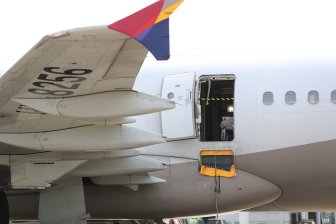Homemade pizzas, 15 guests and a small intimate ceremony in their backyard in -35 C weather.
That’s how Kay and Curtis Ballance celebrated their “perfect” wedding day.
The couple got married at their home in Grand Prairie, Alta., in February this year just seven weeks after giving birth to their first daughter.
Kay Ballance said their preference was to have no guests at all and to just tie the knot at the courthouse, but in Alberta, you are required by law to have a marriage ceremony – which is what they ended up doing.
“The size of our wedding, it actually turned out to be perfect,” said Curtis Ballance.
“The very important people in our lives were there and yeah, just the smaller the better. And it was affordable.”
Kay and Curtis Ballance on their wedding day, Feb. 23, 2023.
Mihaela/MR Photography
Curtis’s dad, who is a chef, made his special cheeseburger pizzas, wings and lasagna, so they didn’t have to spend on catering.
For decorations they rented a $25 wedding arch and Kay bought flowers from the dollar store to make her own floral arrangements.
The total cost of their wedding was around $1,000, the Ballances said – which helped them save for bills, house furnishing and baby toys.
The trend of micro weddings picked up during the COVID-19 pandemic amid limits on large gatherings, forcing couples to go for smaller ceremonies.
But even without the public health restrictions in place, the shift towards less extravagant weddings with a lower price tag amid inflationary pressures has struck a chord with many couples in Canada.

In reaction to the COVID-19 lockdown rules in 2020, Kennedy Event Planning, an Ottawa-based wedding planning agency, launched Petite Weddings, specializing in micro weddings.
Owner Shannon Kennedy said the pandemic has highlighted the charm of smaller weddings.
“I think, through COVID … people are understanding that micro weddings and small weddings are just as joyous and just as big of a celebration as their 200-person component on the other end,” she told Global News.
Bryn Armstrong founded Primp & Pop Event Co., which specializes in pop-up ceremonies, elopements and micro weddings in Muskoka, Toronto and Niagara, Ont., in 2016.
Armstrong said the demand for their services has now petered out a little bit after a surge early on in the pandemic, but she is still seeing a trend toward smaller weddings.
“One of the positive aspects of the pandemic, I suppose, is that it has opened people’s eyes to the flexibility around wedding planning and that there are different versions of the wedding outside of doing a big traditional wedding that is potentially six figures or takes a lot of money.”
Why are micro weddings on the rise?
As Canadians continue to grapple with high prices, one of the main motivations to opt for smaller weddings is financial reasons, wedding planners say.
Shaving off the guest list automatically helps cut costs.
A big traditional wedding of roughly 100 guests can cost up to $50,000, said Mallory Lauder, owner of Lasting Events, a boutique wedding coordinating company in Ontario’s Niagara Region.
For the coming summer, Lauder says they are planning weddings of 50 guests or less, with a price tag of roughly $35,000 or under.
“Weddings aren’t cheap, and given what our economy looks like right now, a lot of people are focusing on trying to save for a home or what the next steps in life are.”

If you are working with a tight wallet and have financial concerns, Lauder’s advice to her clients is to start talking budget very early in the wedding planning process so there are no unexpected expenses or surprises later.
Armstrong said their micro weddings of 20 people are priced between $10,000 and $15,000.
Elopements and pop-up weddings – an all-inclusive package that relieves clients of all the planning stress with the officiant, flowers, photographer and décor provided at the venue – are even cheaper options, costing as little as $5,000.
For some brides and grooms, it’s about personal preference for what they want their big day to look like and what makes them comfortable.
“Some couples just really don’t like being in the limelight so the smaller, more intimate wedding is better for them and that is a comfort zone for them,” said Lauder.

Curtis Ballance said eliminating public speaking in front of a big crowd did take “some pressure off” on their big day.
A second marriage or a wedding after giving birth to a child are other reasons why couples go for smaller receptions, planners say.
It’s also about priorities as some would rather put that extra wedding expense toward other life goals, such as buying a new house, starting a family or spending more on their honeymoon, said Armstrong.
Planning big weddings can be stressful, too, which is why couples are tempted to go the simpler, smaller route, Armstrong added.
“There’s also a stress factor in planning a bigger wedding. We have couples who are … really focused on their professional aspect of their lives. They’re very busy in their family life, so having the added stress of planning a really big event is not what they want.”
Hosting a micro wedding also comes with the advantage of using alternative venues, such as restaurants, boutique hotels and Airbnbs that would not be able to accommodate large groups, said Kennedy.
How are couples cutting wedding costs?
Besides a smaller guest list, e-invites instead of mailed printed invitations are another way that couples are saving their dollars.
They also avoid any design costs by turning to companies that offer a wide range of templated invites online, said Lauder.
Decorations can take up a huge chunk of the wedding budget – and that is where an increasing number of people are taking a simpler affordable route, she added.
“We have seen a large trend in people going more minimalist in their decor as well, and that has really reduced a lot of people’s budgets.”
Kay Ballance made her own flower arrangements for her wedding.
Mihaela/MR Photography.
Kennedy said she has also noticed shorter cocktail hours with the bar wrapping up early, which is a great way to save costs on alcohol.
When it comes to outfits for the day, brides typically want to buy their dress instead of renting but selling afterward “definitely is on the rise,” said Lauder.
Kay Ballance bought her dress online for a couple of hundred dollars, while her husband Curtis rented his tux.
More and more couples are also choosing to remain in the same clothes throughout the day – moving away from multiple wardrobe changes, for instance, for the ceremony, reception and dance party afterward, said Kennedy.
When you host the wedding can also go a long way into stretching your dollars.
Off-peak months between November and April, weekdays and serving lunch or brunch instead of dinner are great ways to reduce wedding costs, said Armstrong.
“The season makes a big impact. If you’re planning a summer wedding when a majority of the other weddings are happening in Ontario, (then) the prices escalate.”
More on Lifestyle



